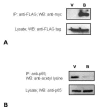Breast cancer metastasis suppressor 1 (BRMS1) inhibits osteopontin transcription by abrogating NF-kappaB activation
- PMID: 17227585
- PMCID: PMC1796551
- DOI: 10.1186/1476-4598-6-6
Breast cancer metastasis suppressor 1 (BRMS1) inhibits osteopontin transcription by abrogating NF-kappaB activation
Abstract
Background: Osteopontin (OPN), a secreted phosphoglycoprotein, has been strongly associated with tumor progression and aggressive cancers. MDA-MB-435 cells secrete very high levels of OPN. However metastasis-suppressed MDA-MB-435 cells, which were transfected with breast cancer metastasis suppressor 1 (BRMS1), expressed significantly less OPN. BRMS1 is a member of mSin3-HDAC transcription co-repressor complex and has been shown to suppress the metastasis of breast cancer and melanoma cells in animal models. Hence we hypothesized that BRMS1 regulates OPN expression.
Results: The search for a BRMS1-regulated site on the OPN promoter, using luciferase reporter assays of the promoter deletions, identified a novel NF-kappaB site (OPN/NF-kappaB). Electrophoretic mobility shift assays and chromatin immunoprecipitations (ChIP) confirmed this site to be an NF-kappaB-binding site. We also show a role of HDAC3 in suppression of OPN via OPN/NF-kappaB.
Conclusion: Our results show that BRMS1 regulates OPN transcription by abrogating NF-kappaB activation. Thus, we identify OPN, a tumor-metastasis activator, as a crucial downstream target of BRMS1. Suppression of OPN may be one of the possible underlying mechanisms of BRMS1-dependent suppression of tumor metastasis.
Figures




Similar articles
-
Breast cancer metastasis suppressor 1 inhibits gene expression by targeting nuclear factor-kappaB activity.Cancer Res. 2005 May 1;65(9):3586-95. doi: 10.1158/0008-5472.CAN-04-3139. Cancer Res. 2005. PMID: 15867352
-
Downregulation of osteopontin contributes to metastasis suppression by breast cancer metastasis suppressor 1.Int J Cancer. 2008 Aug 1;123(3):526-34. doi: 10.1002/ijc.23542. Int J Cancer. 2008. PMID: 18470911
-
Breast cancer metastasis suppressor 1 functions as a corepressor by enhancing histone deacetylase 1-mediated deacetylation of RelA/p65 and promoting apoptosis.Mol Cell Biol. 2006 Dec;26(23):8683-96. doi: 10.1128/MCB.00940-06. Epub 2006 Sep 25. Mol Cell Biol. 2006. PMID: 17000776 Free PMC article.
-
Osteopontin: it's role in regulation of cell motility and nuclear factor kappa B-mediated urokinase type plasminogen activator expression.IUBMB Life. 2005 Jun;57(6):441-7. doi: 10.1080/15216540500159424. IUBMB Life. 2005. PMID: 16012053 Review.
-
Breast carcinoma metastasis suppressor gene 1 (BRMS1): update on its role as the suppressor of cancer metastases.Cancer Metastasis Rev. 2015 Dec;34(4):611-8. doi: 10.1007/s10555-015-9583-z. Cancer Metastasis Rev. 2015. PMID: 26328523 Review.
Cited by
-
Parthenolide Induces Apoptosis in Committed Progenitor AML Cell line U937 via Reduction in Osteopontin.Rep Biochem Mol Biol. 2016 Apr;4(2):82-8. Rep Biochem Mol Biol. 2016. PMID: 27536701 Free PMC article.
-
Prognostic significance of BRMS1 expression in human melanoma and its role in tumor angiogenesis.Oncogene. 2011 Feb 24;30(8):896-906. doi: 10.1038/onc.2010.470. Epub 2010 Oct 11. Oncogene. 2011. PMID: 20935672 Free PMC article.
-
In Vivo Activation and Pro-Fibrotic Function of NF-κB in Fibroblastic Cells During Pulmonary Inflammation and Fibrosis Induced by Carbon Nanotubes.Front Pharmacol. 2019 Oct 2;10:1140. doi: 10.3389/fphar.2019.01140. eCollection 2019. Front Pharmacol. 2019. PMID: 31632276 Free PMC article.
-
Adenosine restrains ILC2-driven allergic airway inflammation via A2A receptor.Mucosal Immunol. 2022 Feb;15(2):338-350. doi: 10.1038/s41385-021-00475-7. Epub 2021 Dec 17. Mucosal Immunol. 2022. PMID: 34921233
-
BRMS1 suppresses breast cancer experimental metastasis to multiple organs by inhibiting several steps of the metastatic process.Am J Pathol. 2008 Mar;172(3):809-17. doi: 10.2353/ajpath.2008.070772. Epub 2008 Feb 14. Am J Pathol. 2008. PMID: 18276787 Free PMC article.
References
-
- Singhal H, Bautista DS, Tonkin KS, O'Malley FP, Tuck AB, Chambers AF, Harris JF. Elevated plasma osteopontin in metastatic breast cancer associated with increased tumor burden and decreased survival. Clin Cancer Res. 1997;3:605–611. - PubMed
-
- Rudland PS, Platt-Higgins A, El-Tanani M, De Silva Rudland S, Barraclough R, Winstanley JH, Howitt R, West CR. Prognostic significance of the metastasis-associated protein osteopontin in human breast cancer. Cancer Res. 2002;62:3417–3427. - PubMed
Publication types
MeSH terms
Substances
Grants and funding
LinkOut - more resources
Full Text Sources
Medical
Research Materials
Miscellaneous

